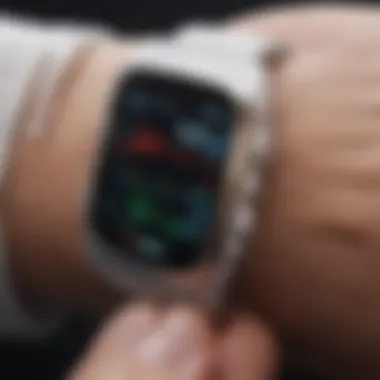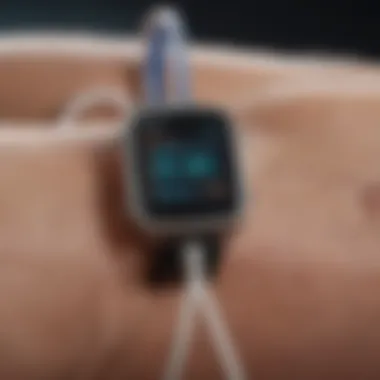Pulsatility Index and Pulse Oximetry in Diagnostics


Intro
The interconnectedness of cardiovascular and respiratory health is a crucial aspect of medical diagnostics. Two parameters significantly contribute to this understanding: the pulsatility index and pulse oximetry. Both metrics are valuable in evaluating patient conditions and guiding clinical decisions. This article will examine their definitions, methodologies, and clinical applications, providing an in-depth narrative that serves as a resource for students, researchers, educators, and professionals in the medical field.
Research Background
Overview of the Scientific Problem Addressed
Assessing cardiovascular and respiratory health has long posed a challenge for clinicians. Traditional methods often fall short in offering comprehensive insights into blood flow dynamics and oxygenation levels. The pulsatility index serves as a sophisticated measure of blood flow resistance in arteries, while pulse oximetry provides real-time feedback on blood oxygen saturation. Together, they enable a more granular understanding of a patient's physiological status.
Historical Context and Previous Studies
The pulsatility index was first introduced in the 1980s as a tool for evaluating vascular conditions. Its utility in obstetric care became apparent, particularly in assessing fetal health during pregnancy. Pulse oximetry, on the other hand, emerged in the late 20th century, gaining widespread use in surgical and critical care settings. Various studies have demonstrated the effectiveness of both parameters in enhancing patient monitoring and prognosis. Notable investigations have reported improved outcomes when these metrics are integrated into healthcare protocols.
Findings and Discussion
Key Results of the Research
Recent research highlights the growing acceptance of pulsatility index and pulse oximetry in clinical practice. Studies have shown that the pulsatility index is not only relevant for obstetric assessments but also provides insights into cardiovascular diseases and vascular resistance disorders. Similarly, pulse oximetry has proven to be indispensable in managing respiratory conditions such as chronic obstructive pulmonary disease (COPD) and during sedative procedures.
Interpretation of the Findings
The findings suggest that both the pulsatility index and pulse oximetry can significantly improve diagnostic accuracy and patient outcomes. Their use allows healthcare professionals to tailor interventions based on individual needs, thereby optimizing treatment pathways. Furthermore, advancements in technology have enhanced the usability and accuracy of these measurements, facilitating their integration into routine clinical practice.
"Understanding these metrics is imperative for any healthcare professional aiming to improve patient care and outcomes."
The exploration of the pulsatility index and pulse oximetry is ongoing. As technology advances, so too will the capabilities and applications of these measures in medical diagnostics. Researchers continue to explore potential enhancements, aiming to provide even more reliable tools for assessing cardiovascular and respiratory health.
By synthesizing findings on these two critical metrics, the healthcare community can refine diagnostic strategies, leading to better-informed clinical decision-making.
Understanding Pulsatility Index
The pulsatility index (PI) plays a pivotal role in medical diagnostics, particularly in cardiovascular assessments. It serves as a quantitative measure of blood flow resistance in arteries and offers insights into the health of vascular systems. Understanding pulsatility index is essential in several clinical contexts, including obstetrics, where it helps in evaluating fetal well-being. As such, grasping its definition, computation, and clinical application is paramount for healthcare professionals.
Definition and Significance
The pulsatility index is defined as the ratio of the difference between peak systolic velocity and end-diastolic velocity to the mean velocity of blood flow in a vascular segment. This metric provides insight into the hemodynamic status of blood vessels. A higher pulsatility index indicates greater vascular resistance, which may signal conditions like hypertension or arterial blockage, while a lower value can suggest reduced resistance, potentially indicating improved blood flow. Thus, the PI serves as an important diagnostic tool in clinical practice, highlighting conditions that may require intervention.
Calculation of Pulsatility Index
To calculate the pulsatility index, clinicians utilize the formula:
where ( V_systolic ) is the peak systolic velocity, ( V_diastolic ) is the end-diastolic velocity, and ( V_mean ) is the average velocity during the cardiac cycle. Accurate measurement of these velocities typically requires the use of Doppler ultrasound techniques. Knowing how to obtain and interpret these velocity measurements is essential for clinicians in order to make informed decisions based on PI results.
Clinical Applications
The clinical applications of the pulsatility index are diverse. In obstetrics, it allows for the assessment of placental function and fetal health. Abnormal PI readings during pregnancy can indicate issues such as fetal growth restriction or preeclampsia. Beyond obstetrics, the PI is utilized in cardiovascular evaluations, assessing arterial stiffness, and determining the presence of vascular diseases. Furthermore, critical care settings may also apply the PI in monitoring patients after significant trauma or surgery, as changes in pulsatility can reflect alterations in hemodynamics.
Limitations and Considerations
Despite its utility, the pulsatility index has limitations that must be acknowledged. Factors such as patient movement, difficulty in obtaining accurate Doppler signals, or hemodynamic changes due to medications can affect the reliability of PI readings. Moreover, variations exist based on the vessel and patient demographics, like age and underlying health conditions. It's crucial for clinicians to consider these factors when interpreting PI results to avoid potential misdiagnoses. Additionally, the pulsatility index should be viewed as one component within a broader diagnostic framework.


Understanding the intricacies of pulsatility index is vital. It assists not only in diagnosis but also in creating tailored treatment plans that can significantly improve patient outcomes.
In summary, a thorough understanding of the pulsatility index enhances clinical judgment, enabling practitioners to leverage this important tool effectively. As medical science advances, continued research on PI applications presents opportunities for improved diagnostic capabilities.
Pulse Oximetry Explained
Pulse oximetry plays a crucial role in contemporary medical practice, serving as a non-invasive method for measuring blood oxygen saturation levels. This ability to monitor oxygen levels is vital for assessing patients' respiratory health and ensuring adequate oxygenation. In a clinical setting, such insights become invaluable for a wide range of patients, from those in critical care to individuals undergoing routine check-ups. Understanding its mechanisms, interpretations, clinical relevance, and factors impacting its accuracy is essential for healthcare professionals aiming for precise and informed decision-making.
Mechanism of Action
Pulse oximetry operates by utilizing light absorption principles. A pulse oximeter is a device that typically clips onto a fingertip or earlobe. It employs two light-emitting diodes (LEDs) that emit light wavelengths—one in the red spectrum and another in the infrared spectrum. These wavelengths penetrate the skin and underlying tissues, where they are absorbed differently by oxygenated and deoxygenated hemoglobin.
This differential absorption assists in calculating the oxygen saturation level, known as SpO2. The device computes the ratio of absorbed light at each wavelength. The resulting value reflects the percentage of hemoglobin molecules saturated with oxygen, a critical indicator of respiratory function. The mechanism is straightforward yet remarkably effective, allowing for rapid assessment without the discomfort of blood draws.
Reading and Interpreting Results
Interpreting pulse oximetry readings is fundamental for diagnosing and monitoring patients. A typical pulse oximeter displays SpO2 values ranging from 0% to 100%, with readings above 95% considered normal for healthy adults. Values below 90% may indicate hypoxemia, requiring further investigation or immediate intervention.
Emphasis should also be placed on understanding waveform signals that accompany SpO2 readings. These waveforms reflect the pulse's characteristics and can provide insights into the quality of the measurement. A well-defined waveform signals a reliable reading, while a weak or irregular waveform may suggest issues with blood flow to the sensor, potential patient movement, or other factors that could distort the accuracy of the readings.
Clinical Relevance
The clinical relevance of pulse oximetry cannot be overstated. It is widely used in various scenarios, including:
- Critical care: Monitoring oxygen levels in emergency situations or intensive care units.
- Anesthesia: Ensuring patients maintain adequate oxygenation during surgical procedures.
- Chronic Respiratory Issues: Managing conditions like COPD or asthma, where oxygen levels may fluctuate significantly.
- Home health: Allowing patients with respiratory conditions to monitor their oxygen saturation independently.
By providing timely information, pulse oximetry helps clinicians make informed decisions about supplemental oxygen therapy or interventions that may be necessary based on oxygen saturation levels.
Factors Affecting Accuracy
Despite its effectiveness, several factors can affect the accuracy of pulse oximetry readings. Recognizing these variables is essential for healthcare providers.
- Skin pigmentation: Darker skin tones may lead to slight variations in readings.
- Nail polish and artificial nails: These can interfere with light transmission, yielding inaccurate results.
- Peripheral vascular conditions: Poor circulation can lead to misleading readings, as it may affect how well the sensor can detect the pulse.
- Movement: Patient movement during measurement can disrupt the device's ability to interpret data correctly.
- External light interference: Bright ambient light can affect sensor readings, especially in outdoor environments.
Maintaining awareness of these factors and taking corrective measures are key to ensuring reliable results.
"Pulse oximetry remains one of the simplest and most vital technologies for assessing oxygen status in patients, contributing substantially to patient safety and management decisions."
Understanding these basic principles of pulse oximetry allows medical professionals to harness its full potential effectively. It empowers them to make informed clinical decisions and provides patients with a straightforward approach to managing their respiratory health.
Pulsatility Index in Obstetrics
Pulsatility Index has become a significant parameter in the field of obstetrics. It offers crucial insights into fetal well-being and uterine blood flow. Understanding this index can help healthcare professionals make informed decisions during pregnancy. When assessing a fetus, the pulsatility index provides data about the resistance to blood flow in uterine and umbilical arteries. Consequently, it serves as a valuable tool in prenatal evaluations. Overall, the pulsatility index plays a vital role in the management of pregnancies.
Role in Fetal Assessment
In fetal assessment, pulsatility index reflects the state of blood flow to the fetus. This information is essential in determining whether the fetus is receiving adequate oxygen and nutrients. A lower pulsatility index often indicates better blood flow, which is generally associated with normal fetal conditions. Conversely, a higher index may signal potential issues, such as placental insufficiency or other complications. Healthcare professionals often measure this value through Doppler ultrasound.
During routine check-ups, practitioners can track changes in the pulsatility index. Regular monitoring helps to identify any deviations that may require further investigation or intervention. This process not only aids diagnosis but also improves outcomes by facilitating timely management. In many cases, earlier detection of issues leads to better fetal health.
Indicators of Complications


The pulsatility index can highlight potential complications during pregnancy. For instance, abnormal values may indicate conditions such as preeclampsia or intrauterine growth restriction. These issues can severely impact fetal development.
Potential indicators using the pulsatility index include:
- Increased resistance in blood vessels
- Changes in fetal heart rate patterns
- Deterioration of placental function
When healthcare professionals observe these signs, they can implement appropriate interventions. These may involve increased surveillance, medications, or referrals for specialized care.
"By monitoring the pulsatility index, obstetricians can foresee potential complications before they escalate."
Evaluating Uteroplacental Circulation
Evaluating uteroplacental circulation is one of the most critical applications of the pulsatility index. This index allows clinicians to assess the adequacy of blood flow between the placenta and the fetus. Adequate uteroplacental circulation is essential for healthy fetal development. Insufficient blood flow can lead to various complications, affecting growth and overall health.
To evaluate uteroplacental circulation, practitioners focus on the umbilical artery's pulsatility index. Abnormal results may prompt additional tests to ensure fetal health. In cases where problems arise, early detection can guide interventions, such as more frequent monitoring or adjustments in maternal care.
Integrating Pulse Oximetry in Clinical Practice
Pulse oximetry has fundamentally changed clinical practices in various medical settings. This section delves into its significance and applications, demonstrating how it enhances patient care.
Monitoring in Critical Care
In critical care environments, continuous monitoring of a patient's oxygen saturation is vital. Pulse oximetry provides real-time data which is crucial for assessing the effectiveness of oxygen therapy and overall respiratory function.
"In critical care, timely intervention can be lifesaving, making pulse oximetry an invaluable tool."
Key benefits of integrating pulse oximetry in such settings include:
- Early detection of hypoxemia: Quick identification of low blood oxygen levels allows for prompt adjustments in treatment.
- Non-invasiveness: Unlike arterial blood gas tests, pulse oximetry is safe and comfortable, reducing distress for patients, particularly those already in critical states.
- Ease of use: The simplicity of applying a pulse oximeter facilitates use by various healthcare staff, regardless of their level of training.
Critical care units often rely on continuous oximetry, providing necessary data for decision-making, ultimately improving outcomes for patients.
Use in Surgical Settings
In surgical settings, pulse oximetry plays a crucial role in monitoring patients’ oxygen status during procedures.
Surgeons and anesthesiologists utilize pulse oximeters to ensure that patients maintain adequate oxygen levels throughout surgery. The following points highlight its importance in these environments:
- Intraoperative monitoring: Continuous tracking prevents oxygen desaturation, allowing for immediate intervention as needed.
- Postoperative care: Oximetry continues to provide insights during recovery, ensuring no complications arise from anesthesia or surgical procedures.
- Guiding anesthetic depth: Knowing a patient's oxygen saturation levels informs the team about the impact of anesthesia on respiration, enabling more precise management.
Integrating pulse oximetry within surgical protocols enhances patient safety and supports effective anesthetic management, ensuring optimal care.
Role in Emergency Medicine
Emergency medicine relies heavily on rapid assessment and treatment. In this domain, pulse oximetry serves as a critical tool in patient evaluation.
In emergency situations, oximetry helps:
- Assess initial patient condition: Low oxygen saturation can indicate severe underlying issues requiring immediate action.
- Monitor treatment efficacy: Continuous oximetry in an emergency can show how well interventions are working, such as supplemental oxygen delivery.
- Guide triage decisions: In emergencies, knowing a patient's oxygenation status aids in determining the urgency of care needed compared to others.
The integration of pulse oximetry into emergency medicine not only streamlines assessment but also enhances response times and patient outcomes, proving its indispensable role.


Comparative Analysis of Pulsatility Index and Pulse Oximetry
Understanding the comparative analysis of pulsatility index and pulse oximetry is essential for researchers and healthcare professionals alike. Both metrics have distinct yet complementary roles in assessing patient health. By analyzing their differences and similarities, one can gain valuable insights into cardiovascular and respiratory conditions. This section aims to explore the physiological insights and diagnostic accuracy of these two important diagnostic tools, providing a framework for their application in clinical settings.
Physiological Insights
The pulsatility index serves as an indicator of vascular resistance and blood flow characteristics within the arterial system. Measuring the pulsatility index involves assessing the variations in blood volume during the cardiac cycle. This metric is especially critical in obstetrics, where it gives insight into fetal well-being and placental blood flow. High or low pulsatility index readings can indicate underlying medical issues that may affect both mother and baby.
Pulse oximetry, on the other hand, focuses on the oxygen saturation of hemoglobin in circulating blood. By using light absorbance technology, pulse oximeters measure the percentage of oxygen-rich blood. This metric is crucial for evaluating respiratory function and ensuring adequate oxygen delivery to tissues throughout the body.
Both parameters provide clinicians with physiological data that can aid in treatment decisions. While the pulsatility index focuses on hemodynamics, pulse oximetry provides a real-time view of oxygenation status. Together, they highlight different aspects of patient health, allowing for a more comprehensive evaluation.
Diagnostic Accuracy
Diagnostic accuracy is a key aspect of both pulsatility index and pulse oximetry. Several factors influence the reliability of these metrics.
For the pulsatility index:
- Technical skill: Accurate measurements depend on the operator's proficiency in ultrasound techniques.
- Patient condition: Structural abnormalities or variations in patient anatomy can affect the results.
- Equipment quality: The technology used to measure blood flow may contribute to discrepancies in readings.
In pulse oximetry:
- Peripheral perfusion: Poor circulation can lead to reduced accuracy in oxygen saturation readings.
- Skin pigmentation: Certain skin tones may affect the measurement, leading to falsely low readings.
- External light interference: Ambient light can interfere with the device's algorithms, producing inaccurate results.
It is crucial to consider these factors when interpreting results from either pulsatility index or pulse oximetry. Accurate diagnostic evaluations depend on a clear understanding of how various elements impact measurement reliability.
Ultimately, both the pulsatility index and pulse oximetry serve vital roles in medical diagnostics. Their comparative analysis enhances clinical decision-making, ensuring that healthcare providers deliver the best possible care.
Future Directions
The exploration of future directions in the context of pulsatility index and pulse oximetry is essential. It provides insights into how these metrics can evolve with advancements in technology and research methodologies. Both pulse oximetry and pulsatility index measurements hold significant promise for enhancing patient diagnostics. As the field progresses, understanding the future trajectory can aid clinicians, researchers, and educators in maximizing these tools for better health outcomes.
Technological Advancements
Technological advancements play a crucial role in improving the accuracy and efficiency of pulsatility index and pulse oximetry measurements. Innovations in medical devices are enabling more precise readings and making monitoring less invasive. For instance, the development of wearable technology is a notable advancement. Devices that integrate pulsatility index calculations and pulse oximetry readings pave the way for continuous monitoring outside clinical settings.
Moreover, algorithms that can analyze trends within pulsatility index data could provide real-time insights for early detection of potential health issues. This shift towards real-time data analysis opens avenues for improving patient care.
"The integration of advanced technology with clinical practice holds the potential to revolutionize how we understand and respond to patient health needs."
Research Trends
Research trends in pulsatility index and pulse oximetry are continuously evolving, driven by the need for enhanced methodologies in medical diagnostics. Ongoing studies focus on refining the protocols used in these measurements, scrutinizing their effectiveness in different patient populations. There's an increasing interest in understanding how these indices correlate with various health conditions, from cardiovascular diseases to respiratory complications.
Additionally, interdisciplinary research is becoming more prevalent. Collaborations between engineers, data scientists, and medical professionals are essential to producing innovative approaches that integrate these metrics with emerging modalities such as artificial intelligence. Through such collaborations, the potential for predictive analytics using pulsatility index and pulse oximetry data becomes more feasible.
Highlighting these research trends provides a foundation for professionals looking to engage with the latest developments in the field. A focus on continuous learning and staying updated with emerging findings will help elevate the practice of medicine and enhance diagnostic capabilities.
End
The conclusion serves as a vital component in summarizing the key insights and implications derived from the study of both the pulsatility index and pulse oximetry. The synthesis of these two diagnostic tools reveals their significant roles in clinical practice, enhancing patient assessment regarding cardiovascular and respiratory health.
It is critical to recognize that both metrics offer unique and complementary information. The pulsatility index, by highlighting changes in arterial blood flow, provides essential insights in various medical contexts, especially in obstetric and vascular assessments. On the other hand, pulse oximetry contributes vital data concerning oxygen saturation levels, enabling prompt interventions in cases of respiratory distress.
Key Elements of the Finale:
- Complementary Role: The synchronized application of these tools can lead to a more comprehensive picture of a patient’s health, offering insights that no single method can accomplish alone.
- Clinical Relevance: Their combined use is not just beneficial in diagnostics but also in monitoring, especially in critical care settings. Understanding how to interpret and utilize both metrics leads to improved clinical outcomes.
- Innovative Approaches: Ongoing research and technological advancements continue to enhance the capabilities and accuracy of these tools. Staying abreast of these developments is essential for practitioners.
"The integration of pulsatility index and pulse oximetry represents a significant step forward in medical diagnostics, bridging the gap between cardiovascular and respiratory assessments."







